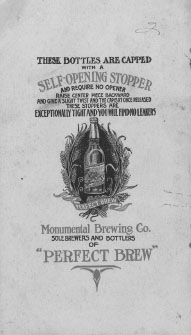Crown Cap is the most widely used closure for beer bottles. Although the design of the crown cap looks obvious to us today, beer bottle closures were  vexing to 19th-century brewers. For carbonated beverages, the most common bottle closure of the late 1800s was the “swing-top” or “flip-top” design, which had a ceramic plug and gasket held in place by wire spring tension (still occasionally seen today, particularly on bottles from the Dutch brewer Grolsch). These were difficult to make and attach to bottles, and aside from this, they simply did not work very well. Gasket materials were not as advanced as they are today, and swing-top bottles often leaked.
vexing to 19th-century brewers. For carbonated beverages, the most common bottle closure of the late 1800s was the “swing-top” or “flip-top” design, which had a ceramic plug and gasket held in place by wire spring tension (still occasionally seen today, particularly on bottles from the Dutch brewer Grolsch). These were difficult to make and attach to bottles, and aside from this, they simply did not work very well. Gasket materials were not as advanced as they are today, and swing-top bottles often leaked.
Certainly there was no lack of ideas for solving the problem. Between 1882 and 1890, the U.S. Patent Office received more than 300 patents for bottle stopper designs. In 1892, mechanical engineer William Painter of Baltimore applied for and received three patents for his “Bottle Sealing Device.” This metal cap could be crimped onto the bottle by machine, and although it needed some force to remove it, the cap held pressure well without leaking. Dubbed the “crown cap” or “crown cork” because of its flared shape before crimping, he had begun work on the closure in 1889. He was not alone—Alfred Louis Bernardin, Sr, of Evansville, Indiana, was hard at work on similar idea, but eventually Painter won out. He founded the Crown Cork and Seal Company and got to work marketing his invention. His crown cap became the worldwide standard for beer bottle closures. The September 15, 1894, issue of The Western Brewer already showed advertisements for the crown cap, with illustrations depicting its easy removal using ordinary household implements such as knives, spoon handles, and even corkscrews.
Not all breweries were quick to take to the new closure, although it worked far better than others and could be easily applied by machines. Eventually, however, there was no denying the superiority of the crown cap, and by the time of Painter’s death in 1909, his company had manufacturing plants on four continents. By the 1930s, Crown Cork and Seal made half the bottle caps in the world.
Other than the linings, the crown cap has changed very little since 1892. In 1927 the thin ring of cork under the metal cap gave way to a patented substitute called Nepro cork, and by the mid 1950s this was replaced by polyvinyl chloride. Today there are versions lined with “oxygen-scavenging” materials that will supposedly remove oxygen from the headspace air and extend the freshness of the beer. A twist-off version of the crown cap was invented in the 1960s and is widely used by large breweries, but largely shunned by smaller breweries and craft breweries. Although it requires no bottle opener to remove it, some brewers believe that it is not as good a barrier to oxygen as the traditional crown cap. The twist-off also gained, perhaps unfairly, a reputation as the closure for cheap beer, a tarnished image that has proved durable.

Brochure promising “no leakers” during use of the new crown cap method of bottle closure, c. 1892. pike microbrewery museum, seattle, wa
